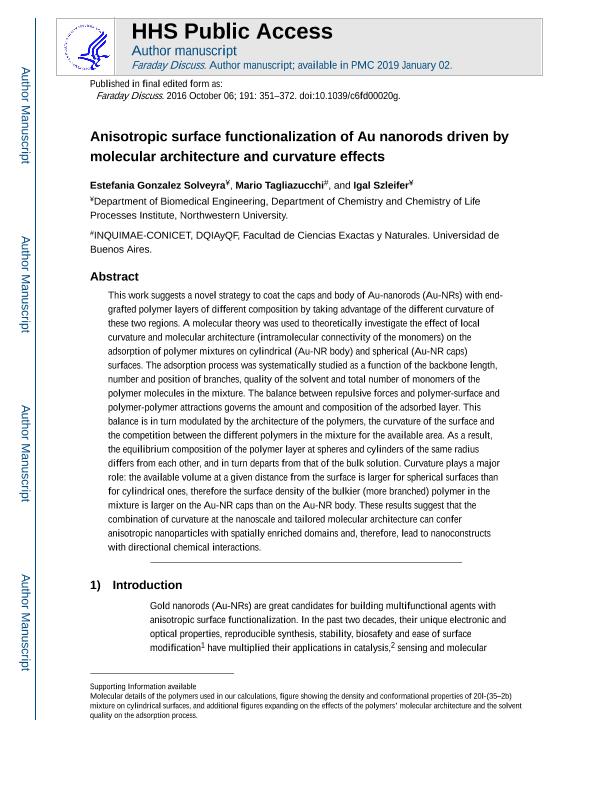Mostrar el registro sencillo del ítem
dc.contributor.author
Gonzalez Solveyra, Estefania

dc.contributor.author
Tagliazucchi, Mario Eugenio

dc.contributor.author
Szleifer, Igal

dc.date.available
2018-09-11T15:41:09Z
dc.date.issued
2016-07
dc.identifier.citation
Gonzalez Solveyra, Estefania; Tagliazucchi, Mario Eugenio; Szleifer, Igal; Anisotropic surface functionalization of Au nanorods driven by molecular architecture and curvature effects; Royal Society of Chemistry; Faraday Discussions; 191; 7-2016; 351-372
dc.identifier.issn
1364-5498
dc.identifier.uri
http://hdl.handle.net/11336/59052
dc.description.abstract
This work suggests a novel strategy to coat the caps and body of Au-nanorods (Au-NRs) with end-grafted polymer layers of different compositions by taking advantage of the different curvature of these two regions. A molecular theory was used to theoretically investigate the effect of local curvature and molecular architecture (intramolecular connectivity of the monomers) on the adsorption of polymer mixtures on cylindrical (Au-NR body) and spherical (Au-NR caps) surfaces. The adsorption process was systematically studied as a function of the backbone length, number and position of branches, quality of the solvent and total number of monomers of the polymer molecules in the mixture. The balance between repulsive forces and polymer-surface and polymer-polymer attractions governs the amount and composition of the adsorbed layer. This balance is in turn modulated by the architecture of the polymers, the curvature of the surface and the competition between the different polymers in the mixture for the available area. As a result, the equilibrium composition of the polymer layer on spheres and cylinders of the same radius differs, and in turn departs from that of the bulk solution. Curvature plays a major role: the available volume at a given distance from the surface is larger for spherical surfaces than for cylindrical ones, therefore the surface density of the bulkier (more branched) polymer in the mixture is larger on the Au-NR caps than on the Au-NR body. These results suggest that the combination of curvature at the nanoscale and tailored molecular architecture can confer anisotropic nanoparticles with spatially enriched domains and, therefore, lead to nanoconstructs with directional chemical interactions.
dc.format
application/pdf
dc.language.iso
eng
dc.publisher
Royal Society of Chemistry

dc.rights
info:eu-repo/semantics/openAccess
dc.rights.uri
https://creativecommons.org/licenses/by-nc-sa/2.5/ar/
dc.subject
Anistropic Nanoparticles
dc.subject
Polymer Adsorption
dc.subject
Molecular Theory
dc.subject.classification
Otras Ciencias Químicas

dc.subject.classification
Ciencias Químicas

dc.subject.classification
CIENCIAS NATURALES Y EXACTAS

dc.title
Anisotropic surface functionalization of Au nanorods driven by molecular architecture and curvature effects
dc.type
info:eu-repo/semantics/article
dc.type
info:ar-repo/semantics/artículo
dc.type
info:eu-repo/semantics/publishedVersion
dc.date.updated
2018-09-04T19:08:13Z
dc.journal.volume
191
dc.journal.pagination
351-372
dc.journal.pais
Reino Unido

dc.journal.ciudad
Cambridge
dc.description.fil
Fil: Gonzalez Solveyra, Estefania. Consejo Nacional de Investigaciones Científicas y Técnicas; Argentina. Northwestern University; Estados Unidos
dc.description.fil
Fil: Tagliazucchi, Mario Eugenio. Consejo Nacional de Investigaciones Científicas y Técnicas. Oficina de Coordinación Administrativa Ciudad Universitaria. Instituto de Química, Física de los Materiales, Medioambiente y Energía. Universidad de Buenos Aires. Facultad de Ciencias Exactas y Naturales. Instituto de Química, Física de los Materiales, Medioambiente y Energía; Argentina
dc.description.fil
Fil: Szleifer, Igal. Northwestern University; Estados Unidos
dc.journal.title
Faraday Discussions

dc.relation.alternativeid
info:eu-repo/semantics/altIdentifier/doi/https://dx.doi.org/10.1039/C6FD00020G
dc.relation.alternativeid
info:eu-repo/semantics/altIdentifier/url/http://pubs.rsc.org/en/Content/ArticleLanding/2016/FD/C6FD00020G
Archivos asociados
